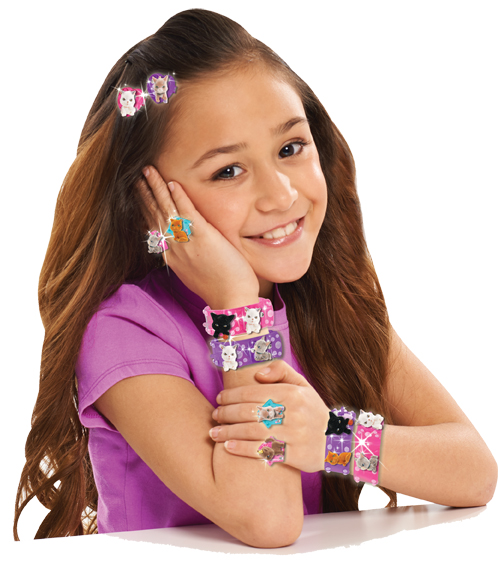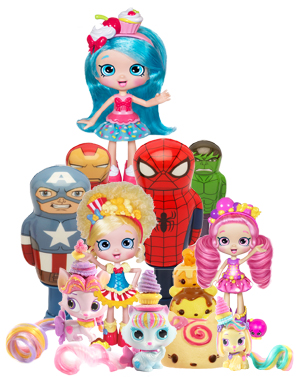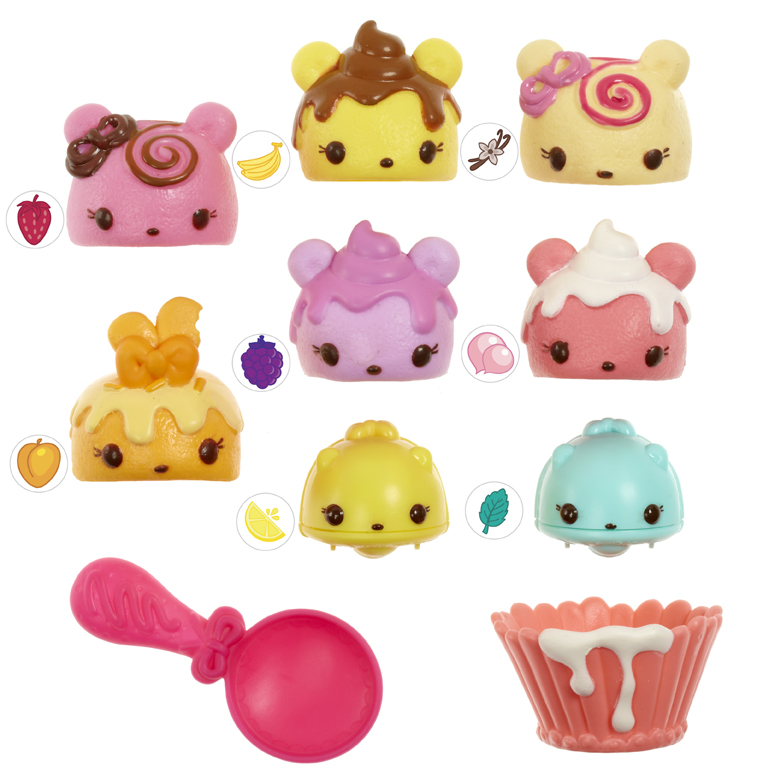Whether it‘s seashells at the beach, multi-colored rocks, or big colorful feathers, kids love to collect odds and ends. For more than a decade, toy companies have cashed in on this quirky habit by introducing toy lines with small price points and big collectibility. In 2016, collectible toys are projected to get smaller in size, but larger in variety and number. With many new offerings already lined up, kids will have a lot more to choose from.
What’s New in 2016?
Moose Toys, a strong contender in the collectibles category for eight years, is getting ready to make a new introduction in the boys‘ collectible category. The company has seen recent success with Shopkins, a line of grocery-themed micro-collectibles with a whimsical appearance, which the manufacturer will continue to grow in 2016.
”We have an exciting new Shopkins segment lined up, new series of toys will continue to come out, as well as an expansion of the Shoppies dolls, who will be interacting a lot more with the characters in the play set,” says Paul Solomon, CEO of Moose Toys.
Blip Toys, on the other hand, is getting ready to flood the market with three collectibles lines, starting with Palace Pets Sweetie Tails, a continuation of the successful Disney Palace Pets inspired by the animal best friends of Disney Princesses. Blip Toys will also launch a brand new collectible line called Sugar Pop in June, and plans to re-launch Squinkies in the fall. ”One of the things that people loved and remembered about Squinkies was their rubbery, tactile nature,” says Rick Mershon, vice president of sales at Blip Toys. ”In 2016 we will differentiate the Squinkies in yet another way. It will be something about the way
they play.”
Kids will also be on the lookout for Num Noms, from MGA Entertainment, which are miniature food toys with customized scents; Batman and Superman Power Poppers from Imperial Toy, which are foam figurines that can be shot into the sky; and Yo-kai medals, from Hasbro, which Yo-kai Watch fans can use to summon their favorite characters.
What’s Trending?
Girls are delving even deeper into collectibles, with toys such as Shopkins, Kitty in My Pocket, and Palace Pets growing in number. ”I feel that collectibles were for a long time action figures like He-Man that targeted boys,” says Ann Kienzle, owner of specialty toy store Play Logan Square. ”This is beginning to change and girl-heavy collectibles are likely to continue in 2016.”
Kienzle also forecasts a rise in superhero collectibles with the huge influx of TV shows and movies themed on the caped crusaders. Superhero toys are easily relatable to all age groups and hence strong sellers, she points out. Star Wars collectibles, however, are an anomaly in that regard because of the perennial interest that fans exhibit in the brand.
Decreasing SIZE
As new brands join the collector‘s cart, the category is getting bigger, but the size of the physical product is shrinking. ”Size impacts affordability, which makes Shopkins so successful,” says Kienzle. ”The key for collectibles is that kids need to be able to save up money in a short amount of time and buy the toys in bulk, otherwise they begin to lose interest.”
However, size is not a sure-shot factor for popularity. ”While micro-collectibles are crowding the market, just making a small-sized collectible toy is not a guarantee for success,” says Ali Barajas, vice president of marketing for Moose Toys.
Creating an entertaining hook, such as telling a back-story for the toy or brand, is one way to draw an audience to a collectible.
”Size certainly adds to the cute factor of the Shopkins,” says Solomon. ”However, other factors like the everyday characters they are styled after, the extensive play pattern that offer role-play opportunities like cooking or shopping, and keeping the newness alive, is what works for Shopkins.”
Artistic VS. Play Value
A collectible by definition is a toy that a child would find attractive enough to buy repeatedly, build a display of, and trade. Hence, the way a collectible appears to a child is an important marker for the toy‘s success. The artistic value of the toy also helps distinguish it from the competition.
”With our micro-collectibles we like to focus on styling the eyes in a distinct way,” says Mershon. ” It‘s something that Disney has mastered as a business—creating a look of the eye, the shape and size of the pupil—that can be owned.”
Another factor that played into the success of the Squinkies, Power Poppers, and Shopkins is the tactile texture of the toys that kids associate with the brand. ”Kids are tactile by nature so the touching factor creates another way in which they can interact with the toys,” says Barajas. ”Shopkins have a softer texture, and spongy feel. Some Shopkins even have fluff. It gives kids something different from hard plastic.”
Solomon adds that Shopkins stand out because of their pint-size, their cute getup, their endearing aura, and happy looks, styled after distinct influences from Australia.
Blind Bag Packaging
Packaging plays an important role with collectibles, according to Kienzle, because it allows the brand to show off its entire range, communicate the idea behind the series, and keep the buyer hooked.
”Blind box is another big packaging trend that prompts kids to buy more,” she says. ”Kids love the element of not knowing what they are going to get. And if packaging adds a layer to the toy like a mini-mall or vending machine, that‘s always a plus.”
The blind bag has always interested kids with toys like My Little Pony, Shopkins, Care Bears, Hello Kitty, and Palace Pets, according to Mershon. ”It‘s the same effect that we wish to recreate with Squinkies,” he says. ”To make visual noise, with just a little tweak in the packaging to make our toy stand out in the collectibles aisle.”
Adding another layer through packaging allows manufacturers to get creative. Hasbro showcases a collecting book and Yo-kai medals in their packaging which allows fans to not only organize their collection, but also summon more Yo-kai characters into the video game. The Shopkins Scoops Ice Cream Truck is a play set that allows kids to play with the truck but also allows them to use the vehicle to display all their Shopkins characters.
Social Media Matters
While packaging allows manufacturers to create visual noise, digital media is a way to reach your target audience, according to Mershon. ”You can see millions of views on YouTube of blind boxes being opened,” he says. ”Kids get excited just watching other people unbox product. Social media has thus become an important marketing strategy in the sale of collectibles.”
Apps and TV series are another way to create great digital content around a toy. One example is the Care Bears & Cousins TV series that recently launched on Netflix, or the free Disney app that allows fans interested in Blip Toys‘ Palace Pets to discover the back-stories of these characters. ”Within two months of the app‘s launch, 2 million copies of the app were downloaded, going to show how focused the target audience for this product is within the Disney fan club,” says Mershon.
Social media is also an information source, helping kids understand what a toy or game is about, how it plays, and how many followers it attracts. YouTube, Instagram, and Facebook also allow kids to share their toy collections instantly with others.
Why Love Collectibles?
Kids are attracted to collectible toys for reasons as varied as the kids themselves. But, collecting starts in the preschool and elementary school stage when kids begin to notice and compare the toys they own to those of their friends. Mershon points out that this age is ripe for collecting.
Sometimes there is no definitive way of knowing what kids might like or dislike. ”When we started toying with the idea of Palace Pets, the pets to consider were traditional pets like puppies, kitties, and ponies,” Mershon says. ”However, what sold were exotics like tigers. On the other hand, with another brand called Whimsy Pets in the micro-plush segment, the kitties and ponies were the hot favorites.”
Kienzle stresses the social importance of collectibles, because sharing and trading are a part of the process of owning such a toy, while Moose Toys‘ Solomon says the success of collectibles is the success of the idea behind the line, as well as its timely execution, artistic rendition, marketing, packaging, and continued interest in the toy, which works almost like an intricate formula.
Trends usually come and go in a three-year wave. Micro-collectibles might be the new fad of the day, but collectibles always have the potential of becoming classic keepsakes if created and invested in with care.
This article was originally published in the December/January issue of the Toy Book on January 4, 2015.




